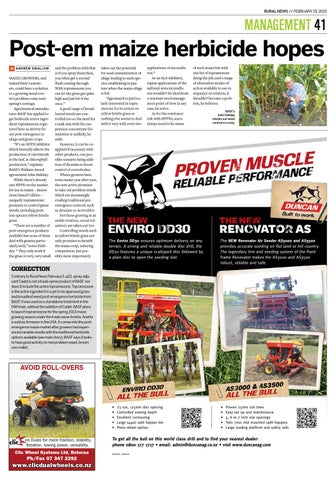Rural News // february 19, 2013
management 41
Post-em maize herbicide hopes andrew swallow
MAIZE GROWERS, and indeed their customers, could have a solution to a growing weed control problem come next spring’s sowings. Agrichemical manufacturer BASF has applied to get herbicide active ingredient topramezone registered here as Arietta for use post-emergence in silage and grain crops. “It’s an HPPD inhibitor which basically affects the production of carotinoids in the leaf, ie chlorophyll production,” explains BASF’s Waikato-based agronomist John Haliday. While there’s already one HPPD on the market for use in maize – mesotrione-based Callisto – uniquely topramezone promises to control grassweeds, including problem species yellow bristle grass. “There are a number of post-emergence products available but none of them deal with grasses particularly well,” notes Halliday. “ They only work if the grass is very, very small
and the problem with that is if you spray them then, you often get a second flush coming through. With topramezone you can let the grass get quite high and just hit it the once.” A good range of broadleaved weeds are controlled too so the need for a tank-mix with the suspension concentrate formulation is unlikely, he adds. However, it can be coapplied if necessary with other products, one possible scenario being addition of dicamba to boost control of convolvulus. Where growers have sown maize year after year, the new active promises to take out problem weeds which are increasingly evading traditional preemergence controls such as Atrazine or Acetochlor. For those growing in an arable rotation, cereal volunteers are taken out too. Controlling weeds such as yellow bristle grass not only promises to benefit the maize crop, reducing competition, but possibly more importantly
takes out the potential for seed contamination of silage leading to such species establishing in pasture when the maize silage is fed. “Agresearch is particularly interested in topramezone for its action on yellow bristle grass as nothing else seems to deal with it very well, even two
applications of nicosulfuron.” As an ALS-inhibitor, repeat applications of the sulfonyl-urea nicosulfuron wouldn’t be ideal from a resistant weed management point of view in any case, he notes. As for the resistance risk with HPPDs, users always need to be aware
of such issues but with one hit of topramezone doing the job, and a range of alternative modes of action available to use in sequence or rotation, it shouldn’t become a problem, he believes. BASF’s John Haliday checks out weed control in a crop.
Correction Contrary to Rural News February 5, p22, spray adjuvant Cadet is not a trade name product of BASF, nor does it include the active topramezone. Topramezone is the active ingredient in a yet to be approved grass and broadleaf weed post-emergence herbicide from BASF. It was used as a standalone treatment in the FAR trials, without the addition of Cadet. BASF plans to launch topramezone for the spring 2013 maize growing season under the trade name Arietta. Arietta is sold as Armezon in the USA. It comes into the postemergence maize market after growers had experienced variable results with the traditional herbicide options available (see main story). BASF says it looks to have good activity on new problem weed, broom corn millet.
AVOID ROLL-OVERS
• • • • •
on Duals for more traction, stability, flotation, towing power, versatility.
Clic Wheel Systems Ltd, Rotorua
Ph/Fax 07 347 2292
www.clicdualwheels.co.nz
23 run, 125mm disc spacing Controlled sowing depth Excellent contouring Large 1440L split hopper bin Press wheel option
• • • • •
Proven 25mm coil tines Easy set up and maintenance 5, 6 or 7 inch row spacings Twin 700L mid mounted split hoppers Large loading platform and safety rails
